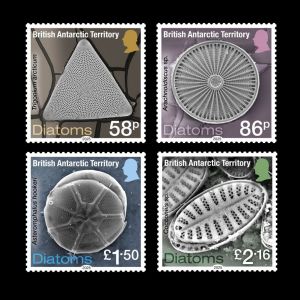
Diatoms are microscopic, single-celled organisms with cell walls (called frustules) made of glass (hydrated silica). The fossil frustules shown in the stamps were found in marine sediment samples collected from the seafloor of the Antarctic Peninsula continental shelf. The cover picture shows several specimens and fragments of Cocconeis species (as on £2.16 stamp) resting on or attached to the girdle band (outer rim) of an Arachnoidiscus species (presented on 86p stamp). The diatoms shown on the 58p and 86p stamps are typically 200-400 microns (0.2-0.4 mm) diameter; the diatom shown in the £1.50 stamp is usually around 30-50 microns diameter and the diatom on the £2.16 stamp has a long axis of 10-20 microns.
Individual frustules range in size from 2 to >500 microns and exhibit a huge variety of shapes and ornamentation. Diatoms grow as solitary cells or more commonly, in colonies of several to several hundred individuals. Cells are linked together by intricately fitted frustules, by mucilage pads, tubes or stalks, or by secreted chitin threads. Despite their tiny size, diatom frustules have the one of the highest strength-to-weight ratios of all known biological materials and can form huge blooms that are visible from space.
Diatoms appear in the fossil record approximately 200 million years ago (Ma), they were minor players in the ocean ecosystem until the opening of new seaways following break-up of the supercontinent of Pangaea during the Cretaceous (140-66 Ma). Some of the earliest marine diatoms are found in the Lower Cretaceous (~110 Ma) sediments of the Weddell Sea, Antarctica. Diatoms continued to diversify and expand into new habitats throughout the Cenozoic (66 Ma to present), including colonisation of freshwater settings. Diatom evolution over the Cenozoic has been so successful that they have become extremely diverse and abundant, with recent estimates ranging from tens of thousands to hundreds of thousands of extant (living) species. This diversity and abundance, coupled with their short life cycle (several days) and adaptation to niche habitats, make diatoms particularly useful indicators of environmental change. As with other plants, a diatom’s ability to survive and thrive depends on their tolerance for temperature, salinity, light and nutrient availability, but also extends to some uniquely adapted species that have evolved to grow on specific plants or animals.
Diatoms are especially important for monitoring and reconstructing ocean and continental environments in the Southern Ocean and Antarctica where pre-satellite era (<1979) observations are sparse and non-existent prior to the 1950s. Also, many other organisms that are used as environmental proxies are absent, only present in low numbers (low abundance or limited diversity) or not preserved in the fossil record.
Using diatoms to track sea surface conditions starts with understanding their modern distribution and habitat preferences in surface waters. Sea surface waters contain up to several hundreds of millions of diatoms per litre, made up of many tens or even hundreds of species. Each species has an ideal habitat and a range of conditions it can tolerate that determine how successfully a species grows and reproduces. Once they die, most frustules will dissolve in seawater as they sink to the sea floor but the ones that make it are preserved in the sediments, creating a continuous archive of sea surface assemblages as they accumulate over time. Marine sediment corers extract and recover tubes of sea floor sediments, allowing us to analyse how the diatom assemblage varies over time and what these changes tells us about past ocean conditions. For example, the fossil diatom assemblages in 20,000 year old sediments from the deep Southern Ocean contain a much higher percentage of sea ice affiliated species than in younger sediments, reflecting the greatly expanded seasonal sea ice that occurred at that time (last glacial maximum).
Traditional uses for diatoms in industry are based on their bulk properties resulting from their porous structure and silica composition for products and processes that involve filtration, absorption, abrasion or insulation. Today, the availability of advanced micro- and nano-scale analytics have prompted research into a wide range of industrial and commercial applications for diatoms, including many emerging bio-, nano- and green- technologies. The main source of inspiration comes from the diatoms ability to generate intricately structured silica frustules in thousands of different shapes and across a wide range of sizes, including: optimising use of materials and designs in manufacturing and construction based on the efficient use of silica and structural integrity of diatom frustules; using diatoms as a supplementary cementitious materials (SCM) to reduce the embodied carbon of cement-based materials; and developing optical lenses to manipulate light based on the silica mesh of certain diatom frustules that have evolved to disperse or concentrate UV light into their cells by changing the shape and configuration of their mesh. Increasingly though, it is the biological compounds and processes of diatoms that are gaining attention for new and emerging applications, including: sustainable production of lipids (including omega-3 fatty acids), pigments (fucoxanthin), carbohydrates, and antioxidants in diatoms; using diatom frustules as a platform for drug delivery and biosensors; genetic engineering to modify morphology and enhance production of desired compounds.
Diatoms are amazing in many fascinating and surprising ways!
|
Technical Details |
|
|
Designer Bee Design |
Bee Design |
|
Photography |
58p, 86p, £2.16 & FDC - Dr Claire S Allen (Palaeoceanographer, BAS) £1.50 Professor - Jennifer Pike (School of Earth and Environmental Sciences, Cardiff University) |
|
Printer |
Cartor Security Printing |
|
Process |
Lithography |
|
Stamp Size |
36 x 36mm |
|
Perforation |
13 ¼ x 13 ¼ per 2cms |
|
Sheet Layout |
10 |
|
Release Date |
Expected Mid November 2025 |
|
Production Co-ordination |
Creative Direction (Worldwide) Ltd |
